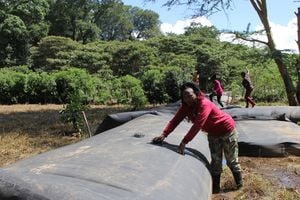Fresh crisis for Ruto as number of hustlers rises

City residents take a nap at Jeevanjee Gardens in Nairobi on October 20, 2022. The fast-growing unemployment rate among the youth aged 20-34 is worrying.
President William Ruto has inherited a ticking time bomb as the number of jobless youth has nearly doubled in three years — and they constitute the majority of the unemployed taking the longest to find employment.
Latest data by Kenya National Bureau of Statistics (KNBS) show that the number of unemployed youth — these are neither in education nor training — has grown by 68 per cent since 2019.
Last year, 3.12 million of those aged 20-34 were jobless, a sharp increase from 1.85 million in 2019 and raising concern about the growing army of the unemployed.
The new data reveals a worrying trend of a fast-growing unemployment rate among the youth aged 20-34 compared to other age groups over the past four years, piling pressure on the government to create jobs for the millions of youth who continue to fuel Kenya’s unemployment crisis.
In 2022, youth falling in that category averaged 3.12 million after growing by 27,829 from 2021. A Nation analysis now shows that since 2019, the number of youth who are not in academic institutions or employment — thus idle — has grown from 1.85 million (or 68.1 per cent).
The number of youth aged 20 to 34 who remained jobless despite not being “in education, employment or training” grew from 2.51 million to 3.088 million between 2020 and 2021, before rising further to 3.12 million last year.
The trend is particularly worrying as you look deeper into the details, which show that youth aged 25 to 34 — being an age where many have graduated from college — equally face unemployment at a high rate, where last year an average of 1.7 million youth within the age group were unemployed.
And this is just a pointer to a bigger unemployment problem in an economy where businesses are already operating under a harsh environment, sandwiched between different sets of local and global factors.
This will form a headache for President William Ruto who rode to State House on a platform to empower hustlers, promising to drive an economic transformation agenda that would create hundreds of thousands of jobs annually, to absorb the high number of youth coming out of universities and colleges.
Kenya Kwanza manifesto
The President, in his pre-election manifesto last year, spoke widely of the untapped economic opportunities to create jobs for about 800,000 youth joining the workforce annually, promising to create at least 200,000 jobs annually in the housing and leather sectors alone.
“When unemployed university graduates ask us how empowering wheelbarrow pushers will do for them, they miss the obvious fact that the demand for the white-collar jobs they desire are dependent on the size of the market.
“The Kenya Kwanza housing commitment is to turn the housing challenge into an economic opportunity. Next to agriculture, we see housing production as the sector that will create quality jobs for the 100,000 or so young people graduating from TVETs every year directly in the construction sector and indirectly through the production of building products,” his manifesto stated.
Over the four years to 2022, the KNBS data also show, the youth population bore the heavy brunt of the population that stays unemployed for longer periods, forming an average of 77 per cent of the population that stayed without a job for over a year.
In 2022, for instance, an average of 426,604 youth aged 20 to 34 reported having been unemployed for over 52 weeks, which was 74.8 per cent of all people who were classified as having been unemployed for such a period in the country.
“Long-term unemployment refers to all unemployed persons with continuous periods of unemployment extending for one year or longer (52 weeks and over),” KNBS states.
And while the number may have been an improvement from the 532,650 youth who were in the same position in 2021 —the period when the country was emerging from the Covid-19 pandemic that caused a loss of jobs — it was a 14.5 per cent increase in the number of such youth since 2019.
Of all Kenyans who were classified as unemployed for long term in the last quarter of the year (October- December), the youth formed 74.8 per cent in 2022, 82.5 per cent (2021), 76.9 per cent (2020) and 74.3 per cent (2019).
Overall, KNBS states, youth have continued to constitute two-thirds of the unemployed population in the country, with the growth rate in their unemployment numbers being especially more pronounced since 2020.
Last year, out of the 2.97 million Kenyans who were unemployed, 1.96 million (66 per cent) were youth.
While this was, however, a slight improvement from the previous year where 70.5 per cent of the unemployed population were the youth, in numbers last year saw 54,857 more youth slide into unemployment.
Since 2020, while overall unemployment in the country grew by 16.2 per cent, unemployment among youth increased at a faster rate of 20 per cent.
The KNBS report comes out at a time different key institutions have warned of a difficult economic environment in the country, where businesses are projecting even tougher times moving forward.
Key among businesses' concerns has been high inflation that has eroded consumers’ purchasing power and in the latest Consumer Price Index (CPI), inflation in March remained above the Central Bank of Kenya (CBK) upper limit for the ninth month since July 2022, at 9.2 per cent.





